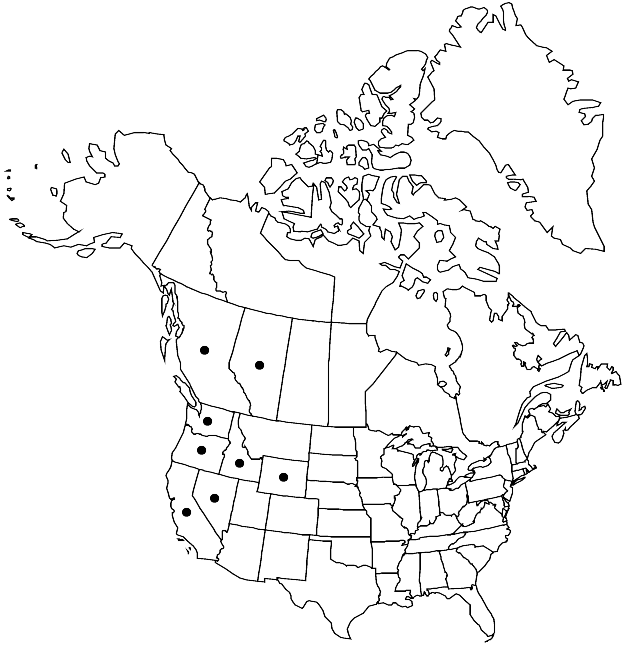Difference between revisions of "Orthotrichum rivulare"
Muscol. Hibern. Spic., 96, plate 8. 1804.
FNA>Volume Importer |
imported>Volume Importer |
||
| (6 intermediate revisions by 2 users not shown) | |||
| Line 9: | Line 9: | ||
|special_status={{Treatment/ID/Special_status | |special_status={{Treatment/ID/Special_status | ||
|code=F | |code=F | ||
| − | |label= | + | |label=Illustrated |
}} | }} | ||
|basionyms= | |basionyms= | ||
| Line 26: | Line 26: | ||
|elevation=low to moderate elevations (0-1000 m) | |elevation=low to moderate elevations (0-1000 m) | ||
|distribution=Alta.;B.C.;Calif.;Idaho;Nev.;Oreg.;Wash.;Wyo.;Europe. | |distribution=Alta.;B.C.;Calif.;Idaho;Nev.;Oreg.;Wash.;Wyo.;Europe. | ||
| − | |discussion=<p>Orthotrichum rivulare is distinguished from all other species in the genus by: leaves often obtuse with margins dentate near the apex; calyptra plicate with projecting edges papillose, otherwise smooth and naked; 16 endostome teeth; and stomata completely covered by overarching subsidiary cells. A key differentiating feature from O. euryphyllum is the flat, dentate apex.</p> | + | |discussion=<p><i>Orthotrichum rivulare</i> is distinguished from all other species in the genus by: leaves often obtuse with margins dentate near the apex; calyptra plicate with projecting edges papillose, otherwise smooth and naked; 16 endostome teeth; and stomata completely covered by overarching subsidiary cells. A key differentiating feature from <i>O. euryphyllum</i> is the flat, dentate apex.</p> |
|tables= | |tables= | ||
|references= | |references= | ||
| Line 35: | Line 35: | ||
-->{{#Taxon: | -->{{#Taxon: | ||
name=Orthotrichum rivulare | name=Orthotrichum rivulare | ||
| − | |||
|authority=Turner | |authority=Turner | ||
|rank=species | |rank=species | ||
| Line 48: | Line 47: | ||
|publication title=Muscol. Hibern. Spic., | |publication title=Muscol. Hibern. Spic., | ||
|publication year=1804 | |publication year=1804 | ||
| − | |special status= | + | |special status=Illustrated |
| − | |source xml=https:// | + | |source xml=https://bitbucket.org/aafc-mbb/fna-data-curation/src/2e0870ddd59836b60bcf96646a41e87ea5a5943a/coarse_grained_fna_xml/V28/V28_94.xml |
|genus=Orthotrichum | |genus=Orthotrichum | ||
|species=Orthotrichum rivulare | |species=Orthotrichum rivulare | ||
Latest revision as of 21:39, 5 November 2020
Plants 1–5 cm, dark green to blackish. Stem leaves erect and loosely appressed when dry, oblong-lingulate, oblong-lanceolate, or ovate-lanceolate, 2.8–5 mm; margins strongly revolute to just below apex, usually irregularly dentate at apex; apex obtuse, flat; basal laminal cells rectangular to short-rectangular, walls thin, not nodose; distal cells 10–13 µm, 1-stratose, papillae 1–3 per cell, conic, small. Specialized asexual reproduction absent. Sexual condition gonioautoicous. Seta 1–1.5 mm. Capsule barely to 3/4 emergent when dry, immersed when moist, oblong to oblong-ovate, 1.5–2.5 mm, strongly 8-ribbed entire length; stomata immersed; peristome double; prostome sometimes present; exostome teeth 8, sometimes splitting to 16, erect, loosely reflexed when old, irregularly papillose, papillae usually confluent forming longitudinal striae; endostome segments 16, occasionally rudimentary, usually of 1 row of cells, finely papillose. Calyptra long-rostrate, papillose, naked. Spores 10–17 µm.
Habitat: Exposed tree roots, base of trees along streams, siliceous boulders at edges of streams and rivers, frequently inundated rock, aquatic habitats
Elevation: low to moderate elevations (0-1000 m)
Distribution

Alta., B.C., Calif., Idaho, Nev., Oreg., Wash., Wyo., Europe.
Discussion
Orthotrichum rivulare is distinguished from all other species in the genus by: leaves often obtuse with margins dentate near the apex; calyptra plicate with projecting edges papillose, otherwise smooth and naked; 16 endostome teeth; and stomata completely covered by overarching subsidiary cells. A key differentiating feature from O. euryphyllum is the flat, dentate apex.
Selected References
None.
